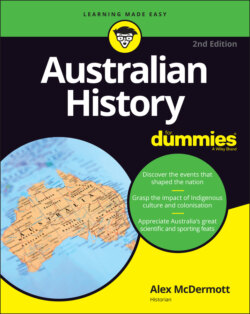Читать книгу Australian History For Dummies - Alex McDermott - Страница 56
Picking a winner: NSW it is!
ОглавлениеAfter the crime explosion in Britain in 1784 and 1785 (refer to the section ‘Losing America and a terrible outbreak of peace’, earlier in this chapter), and the resulting urgent need to get rid of convicts, Banks was pushing for NSW to be established as the settlement to send them to.
However, many other possibilities existed — the Falkland Islands, Newfoundland, Nova Scotia, the West Indies, the East Indies, the Malay Archipelago and South Africa were all mentioned in public debate and were taken more or less seriously. Britain ended up choosing the NSW coast, which these days we tend to assume was natural, even inevitable, but at the time it was an odd choice. Certainly, it was satisfyingly remote — not many escapees paddling their way back to Britain in a hurry — but there was such a thing as too remote for a penal settlement. Ideally, you wanted a port of call on an already existing major trade route. Extremely isolated exile wasn’t preferred from the start — the presumption being that after convicts had served their time, they should be able to catch a ship home.
The proposed Botany Bay colony was outside any established shipping routes, and not a region with great existing trade, meaning that transportation costs would be very high. Although the influence of Banks can’t be denied, what other factors led the British Government to choose NSW? Here the plot thickens. This is an area that sustains a healthy amount of strong disagreement among historians, but some clear factors emerge:
NSW was near vital raw materials for maintaining a global navy: Britain had found out the hard way in recent wars that if shut off from crucial supplies from Europe, their vaunted navy ran the risk of disintegration. Flax plants were needed to make sails, ropes and cords, while long straight timber, preferably pine, was needed to replace masts. Cook had reported spruce pines of ‘vast size’ on Norfolk Island, not far from the NSW coast: ‘Here … masts for the largest ships may be had’. Flax plants were also seen growing in abundance.
Access to all the tea in China could be made less volatile: In the 1780s, trade with the Chinese port of Canton increased dramatically, with the importation of tea tripling in two years alone. But getting there was tricky. The French had established themselves in Indochina (modern-day Vietnam and surrounding areas), and the Dutch held the East Indies (modern-day Indonesia). While the British had signed a treaty that gave them a right to sail through Dutch waters, they worried that in the event of war both regions would become highly dangerous to move through. So an alternative route, one that went from India southwards, below Australia and then up the east coast, sailing between the New South Wales coastline and Norfolk Island, could be a handy Plan B.
The British East India Company’s monopoly was looking likely to end: For most of the 18th century, this company had enjoyed a monopoly over all trade that went back to Britain from India and the entire region that lay beyond, as they came to exercise an often regal-type power in that part of the world. For trading companies and shipping agencies not directly aligned with the company, this monopoly was a profound disincentive for moving operations into the Pacific. The monopoly was widely expected to be terminated in the early 1790s, however, allowing a rush of new trading shipping interest into the area.
The French were still an enemy to be feared: The French and British had an animosity that went back centuries (Joan of Arc, anyone?) but in the second half of the 18th century, Britain and France were locked in an intense battle for global supremacy that often sparked wars. The British Ambassador in Paris in the summer of 1785 reported worrying rumours that the French scientific expedition about to set off under comte de La Pérouse was going to be instructed to establish a convict settlement in New Zealand to take advantage of the pines reputed to be there. Interest in the Pacific and New Holland as a strategic resource was on the rise in the other major player in world affairs.
So why not kill a multiple number of birds with one big convict stone? Convicts were intended as a stop-gap measure to help establish a key British strategic post in the Pacific. Plenty of other reasons could be put forward to establish settlement in NSW, but plenty of good reasons also to keep quiet about it. The British had no wish, after all, to needlessly provoke or alarm the Dutch and French, or to offend British East India Company sensitivities. (The company had been largely shut out of the decision-making for the new settlement, and was already viewing it suspiciously.) Much easier, then, to talk only of offloading unwanted convicts on a coastline that was declared to be land belonging to no-one (see the sidebar ‘Claiming the “terra nullius”’).
In 1786, George III declared to the House of Commons that his government and prime minister would soon transport ‘a number of convicts’ to Botany Bay in order to relieve ‘the crowded state of the gaols’.
